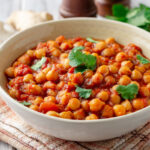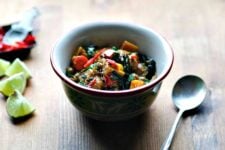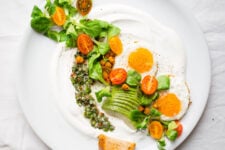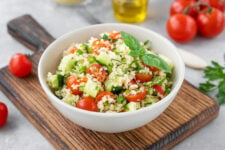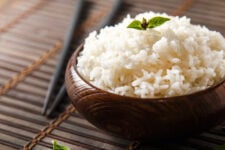Chickpeas, also known as garbanzo beans, are a nutty-tasting legume that is very versatile across many cuisines (1). From hummus to curries to falafel, chickpeas are the star of many flavorful dishes.
You can generally purchase chickpeas in two forms: dried or canned. Cooking dried chickpeas is a lengthy process, involving soaking overnight and then simmering on the stovetop.
Many people choose canned chickpeas since they are pre-cooked, making them a much quicker and more convenient option. You can even eat them straight from the can without heating them up, which is great for salads or making hummus.
However, you may wonder if canned chickpeas are as healthy as dried ones. Learn more about the health benefits and possible risks of canned chickpeas below.
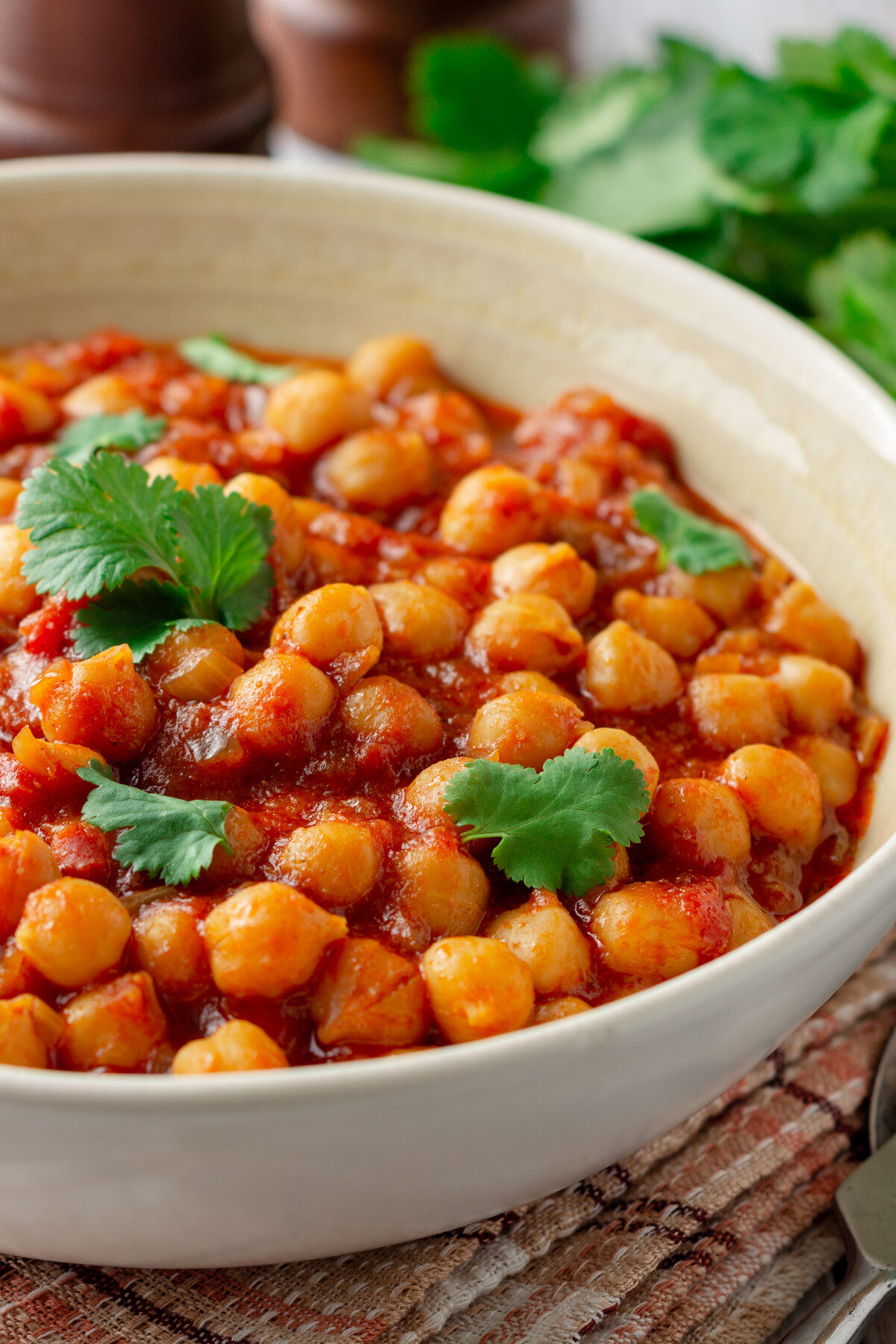
Are Canned Chickpeas Healthy?
Canned chickpeas are a convenient source of fiber, plant protein, and minerals and can help improve blood sugar, cholesterol, and digestive health (2). Most of the valuable nutrients of garbanzo beans are well-preserved in the canning process, though canned chickpeas are generally high in sodium (3).
The primary difference between canned and dried chickpeas is that canned beans are much higher in salt (4, 5). One can of garbanzo beans (including the liquid) contains 1250 mg of sodium, which is more than half of the daily sodium recommendation (10, 11).
This is of concern to anyone watching their sodium intake, though there are ways to reduce the sodium content of canned beans.
Draining the liquid out of the can and rinsing the beans reduces the sodium to 538 mg per can (5). You can also purchase low-sodium or no salt added canned chickpeas.
As with any canned good, some nutrients are lost in the canning process. However, canned chickpeas have been shown to contain comparable amounts of nutrients to dried chickpeas, making the difference in nutrients minimal (3).
Health Benefits of Canned Chickpeas
Canned chickpeas provide numerous health benefits and are considered a nutrient-dense food. Research shows chickpeas are beneficial for weight management, blood sugar regulation, heart disease, and digestive health (1).
Chickpeas (both the canned and dried varieties) are rich in dietary fiber, polyunsaturated fatty acids, β-carotene, iron, potassium, and B vitamins (1, 6, 7).
One cup of canned chickpeas (drained and rinsed) contains (5):
- 210 calories
- 4 g of fat
- 11 g of protein
- 35 g of carbohydrates
- 9.6 g of fiber
- 1.5 mg of iron
- 166 mg of potassium
- 322 mg of sodium
Plant protein
Canned chickpeas are a fantastic source of plant protein and are a very convenient way to add protein to your diet. Though they are not a complete protein, meaning they lack all the essential amino acids, you can combine chickpeas with whole grains to create a complete protein source (1).
The type of protein in garbanzo beans has also been shown to be easier to digest when compared to other legumes (7).
Digestive health
Regularly eating chickpeas can increase your fiber intake while improving gut health. Raffinose is the type of soluble fiber in chickpeas, and it has been shown to help improve the amounts of healthy bacteria in the gut (3).
Chickpeas can help you feel fuller longer after a meal, aiding in weight management (8). In addition, people who eat garbanzo beans are less likely to struggle with constipation (1).
Cardiovascular disease
Chickpeas can be an excellent way to help lower cholesterol levels and reduce cardiovascular risk. This benefit is due to the soluble fiber, unsaturated fats, and plant sterols in garbanzo beans (3).
Studies show that regular chickpea consumption can significantly improve total cholesterol and LDL (“bad”) cholesterol levels (6, 1).
Blood pressure can also be improved by regular consumption of chickpeas, which are exceptionally high in potassium, a blood pressure-lowering micronutrient (1). However, since the sodium content is higher in canned chickpeas, consider purchasing low sodium beans and draining and rinsing them.
Blood sugar
Chickpeas are a low glycemic food due to their fiber content. A one-cup serving of canned chickpeas provides 9.6 grams of fiber, almost 40% of the minimum recommended fiber intake (5, 9).
People often think they must limit or avoid eating legumes because of their carbohydrate content. However, studies show that people who eat garbanzo beans with a meal have a lower blood sugar response than a meal without garbanzo beans (1).
Further, garbanzo beans contain amylose, which is a resistant starch. This type of starch is digested slower than other starches and can improve blood sugar levels and insulin resistance (3).
Risks of Canned Chickpeas
Though canned garbanzo beans have numerous health benefits, there are a couple of risks to be aware of. Aside from the sodium content, other risks include BPA exposure and the risk of botulism, which are concerns with any canned food.
The lining of many canned goods contains Bisphenol A, a controversial chemical that some people wish to avoid due to possible health risks. Its use in food packaging is currently considered safe by the FDA, but safety studies are ongoing.
If you’re concerned about BPA, you can look for canned chickpeas with a “BPA free lining” statement on the label (8).
Botulism is a bacteria that can sometimes grow in canned foods because of the low-oxygen environment. This is more common in home canning but can also happen in store-bought canned goods. If you notice any bulging in the can, avoid purchasing it because it may contain botulism toxins (8).
Is the Liquid from Canned Chickpeas Healthy?
After you drain your canned garbanzo beans, consider saving the liquid. Using the liquid from canned chickpeas, known as “aquafaba,” has become popularized in recent years as a vegan egg alternative in certain baking applications.
If you’re vegan or are allergic to eggs, you can use three tablespoons of aquafaba to replace one egg in baking (3). You can even use it to make meringues!
The primary health concern with aquafaba is the high sodium content, so take caution if you have a health condition that requires you to limit sodium.
Easy Curry with Canned Chickpeas
Ingredients
- 1 tbsp olive oil
- 1 onion diced
- 2 cloves garlic minced
- 1 tsp fresh ginger minced
- 1 jalapeno seeded and sliced
- 2 tbsp garam masala
- 1 tsp turmeric
- 1 tsp salt
- 1/2 tsp black pepper
- 1 can diced tomatoes 14.5 ounce can
- 2 cans chickpeas 15 ounce cans, drained and rinsed
- 1/2 cup water
- 1.2 lemon juiced
- 1/4 cup fresh cilantro chopped
Instructions
- Heat olive oil in large stock pot until oil is shimmering (but not smoking).
- Add onion and sauté until translucent and beginning to brown on the edges (about 3 minutes).
- Add garlic, ginger, and jalapeno pepper. Continue to sauté over medium heat for another 3-4 minutes.
- Add garam masala, turmeric, salt, and pepper and continue cooking for another minute or two.
- Add tomatoes, chickpeas, and water. Stir with a wooden spoon, taking care to scrape the bottom of the pot to incorporate the brown bits from the sautéed mixture.
- Cover and simmer for 15 minutes, stirring occasionally. Add more water, if desired, to achieve desired consistency.
- Remove from heat and uncover. Stir in lemon juice and cilantro. Cover again and let stand for 1-2 minutes.
- Serve over basmati rice and/or with a side of warm naan.

